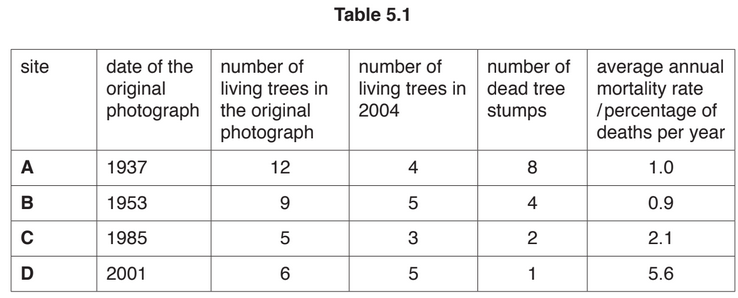Question
The giant quiver tree, Aloe pillansii, shown in Fig. 5.1, is an endangered species.
These long-lived trees grow in harsh environments. Some populations of A. pillansii are found
within the Richtersveld National Park, but one population is found just outside on a mountain
called Cornell’s Kop in southern Africa.
(a) (i) State the genus of the giant quiver tree.
………………………………………………………………………………………………………………………[1]
(ii) Explain why the A. pillansii trees on Cornell’s Kop represent a population.
………………………………………………………………………………………………………………………….
(b) Suggest three reasons why the giant quiver tree is an endangered species.
1 ……………………………………………………………………………………………………………………………….
…………………………………………………………………………………………………………………………………
2 ……………………………………………………………………………………………………………………………….
…………………………………………………………………………………………………………………………………
3 ……………………………………………………………………………………………………………………………….
…………………………………………………………………………………………………………………………………
(c) It was estimated in 2005 that the total number of giant quiver trees in the wild was less than
3000, which is considered to be very low compared with other tree species.
Explain the risks to a plant species of having very small numbers.
…………………………………………………………………………………………………………………………………
(d) The population of A. pillansii trees on Cornell’s Kop was surveyed and photographed at four
sites, A to D, from 1937 onwards. Researchers took photographs at all four sites in 2004 and
compared them with the original photographs.
The results are shown in Table 5.1.
(i) Calculate the percentage decrease in the number of living trees at site B from 1953
to 2004.
Show your working and give your answer to the nearest whole number.
…………………………………………………….%
(ii) Describe what the analysis of the photographs shows about the population of A. pillansii
on Cornell’s Kop.
………………………………………………………………………………………………………………………….
Answer/Explanation
Ans:

Question
(a) Atlantic cod, Gadhus morhua, is a type of fish that is an important resource for commercial
fishing.
Fig. 6.1 shows the estimated mass of Atlantic cod over 40 years.
(i) In 1970, the mass of Atlantic cod was 8000000 tonnes.
State one year when the mass of Atlantic cod was half this value.
(ii) State the years when there was a continuous increase in the mass of Atlantic cod for at least five years.
(iii) Suggest reasons for the trend shown between 1990 and 1995.
(iv) Explain how fish stocks can be conserved by restocking.
(b) Fish have adaptive features that enable them to live successfully in their environment.
Fig. 6.2 is a photograph of a great white shark, Carcharodon carcharias.
Great white sharks are efficient predators and have very good eyesight to see in poor light
conditions underwater.
(i) Describe two features, other than eyesight, visible in Fig. 6.2 that suggest that great
white sharks are efficient predators.
1 ……………………………………………………………………………………………………………………….
2 ……………………………………………………………………………………………………………………….
(ii) Describe how the ancestors of the great white shark developed adaptive features such
as good eyesight.
Answer/Explanation
Answer:
(a)
(i) 1994 / 1995 / 1996 / 1997 / 2007 ;
(ii) at least a 5 year period between 1975 and 1983 ;
(iii) increased predation ;
introduced species / new predators ;
reduction in food supply ;
overfishing / increase in fishing ;
parasites / disease ;
named examples of pollution / eutrophication ;
global warming / climate change / ocean acidification ;
AVP ;
(iv) (captive) breeding programmes ;
release them (into the wild / into protected areas) ;
protected areas;
monitoring of numbers ;
limited fishing (so that wild stocks can recover) ;
using farmed fish / sustainable fish (so wild stocks can recover) ;
AVP ;
(b)
(i) sharp / large teeth ;
lots of teeth ;
big jaws ;
streamlined ;
camouflaged ;
AVP ;
(ii) 1 variation (in eyesight) ;
2 ref. to mutation ;
3 new alleles arise that increases fitness ;
4 (organisms with better eyesight) are better competitors ;
5 organisms with the good eyesight / feature, are more likely to
survive and reproduce ; ora
6 passing on their alleles (for good eyesight) ;
7 eventually all the organisms (in the population) will have the
feature / good eyesight ;
8 ref to natural selection / evolution ;
Question
The Arabian oryx and the northern white rhinoceros are both mammals.
Fig. 5.1 is a photograph of an Arabian oryx. Fig. 5.2 is a photograph of a northern white rhinoceros.
(a) Describe two pieces of evidence visible in Fig. 5.1 and Fig. 5.2 that show these animals are
mammals.
1 ………………………………………………………………………………………………………………………………
2 ………………………………………………………………………………………………………………………………
(b) Different conservation methods are used to try to prevent species from becoming extinct.
A population of the Arabian oryx and a population of northern white rhinoceros were monitored.
Fig. 5.3 shows how the population size of each species has changed over time.
(i) Calculate the percentage increase in the number of Arabian oryx between 1990 and
2000.
Give your answer to three significant figures.
Space for working.
(ii) Describe the data for the northern white rhinoceros shown in Fig. 5.3.
………………………………………………………………………………………………………………………….
………………………………………………………………………………………………………………………….
(c) Suggest the conservation methods that were used to increase the number of Arabian oryx
between 1978 and 2000.
…………………………………………………………………………………………………………………………………
…………………………………………………………………………………………………………………………………
(d) Explain the risks to the northern white rhinoceros species as a result of its population size.
…………………………………………………………………………………………………………………………………
…………………………………………………………………………………………………………………………………
Answer/Explanation
Ans

